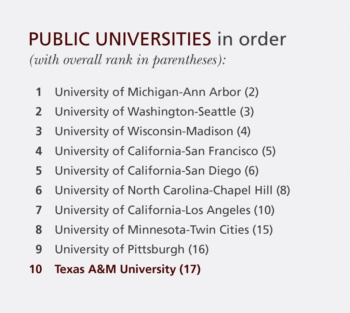Texas A&M Advances To 17th In New NSF Research Rankings

- Texas A&M climbs two positions on NSF’s Higher Education Research and Development (HERD) Survey.
- Survey ranks 895 U.S. colleges and universities based on research and development expenditures.
- Texas A&M remains the state’s only university in the survey’s top 20.
Rising two positions on a list of the top research universities in the United States, Texas A&M University ranks 17th in the latest survey from the National Science Foundation (NSF), based on annual expenditures in research and development.
Released in November 2015, the NSF’s Higher Education Research and Development (HERD) survey bases the ranking on Texas A&M’s reported research and development expenditures during fiscal year 2014 of slightly more than $854 million – a 4.1 percent increase from fiscal 2013, when the university reported $820 million in expenditures and ranked 19th in the survey.
Texas A&M remains the only university in the state to rank among the NSF’s top 20 in total research and development expenditures. Among other Texas-based universities in the top 50, The University of Texas M.D. Anderson Cancer Center ranked 21st on the latest survey with $794.9 million; The University of Texas at Austin ranked 34th with $585 million; the Baylor College of Medicine came in at 40th with $496 million; and The University of Texas Southwestern Medical Center placed 47th with $434.6 million.
In addition, Texas A&M ranks in the top 10 among public research universities cited by the survey (see chart).
“Research is a vital part of our mission at Texas A&M and The Texas A&M University System,” said John Sharp, Chancellor of The Texas A&M University System. “Texas A&M is the largest research university in the Southwest and we anticipate even more explosive growth in the years to come.”
Texas A&M President Michael K. Young said, “Texas A&M’s fulfillment of its land-grant mission of conducting research that addresses the day’s most pressing grand, global challenges is reflected in this and other major rankings. We are proud of our impact on the state, nation and world, and of our culture of innovation and excellence through which we are making an even greater impact in the 21st century.”
Karan L. Watson, provost and executive vice president, said, “Much of the credit for our progress belongs to Chancellor Sharp and President Young, both of whom have praised Texas Gov. Greg Abbott and the Texas Legislature for their strong support of higher education in Texas at a time when many other states are pulling back. We live and work in a state with a strong vision for higher education in general—and for academic research specifically—as an engine for long-term prosperity. We are fortunate that Texas has both the political will and the economic strength to see that vision through.”
Glen A. Laine, vice president for research, said, “Research conducted at Texas A&M is wide, deep and diverse, and much of this research is aimed at solving society’s toughest challenges. Our outstanding faculty-researchers are a critical component in our national ranking. Chancellor Sharp led a unified effort across the Texas A&M System to secure funding that supports major construction and high priority programs, which will play a key role in the coming years as we advance the Texas A&M research enterprise.”
The NSF survey provides a census of 895 degree-granting colleges and universities in the United States, with a minimum budget of at least $150,000 in research and development expenditures. The latest survey found that U.S. universities recorded $67.3 billion in research and development expenditures in fiscal 2014, an increase of 0.2 percent from fiscal year 2013’s total of $67.1 billion.
The nation’s top three research institutions retained their rankings from the previous NSF survey. Johns Hopkins University led the survey with $2.24 billion in expenditures, followed by University of Michigan at Ann Arbor with $1.34 billion, and the University of Washington at Seattle with $1.17 billion.
View Higher Education R&D Expenditures, ranked by all R&D expenditures, by R&D field: FY 2014 at NSF website.
Media Contact: Rusty Cawley, Texas A&M University Research.





